Papers by Barbara Tomassetti
EGU General Assembly Conference Abstracts, Apr 1, 2019
Hydrology and Earth System Sciences, 2021
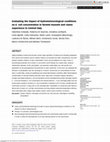
Journal of water and health, 2021
Highly populated coastal environments receive large quantities of treated and untreated wastewate... more Highly populated coastal environments receive large quantities of treated and untreated wastewater from human and industrial sources. Bivalve molluscs accumulate and retain contaminants, and their analysis provides evidence of past contamination. Rivers and precipitation are major routes of bacteriological pollution from surface or sub-surface runoff flowing into coastal areas. However, relationships between runoff, precipitation, and bacterial contamination are site-specific and dependent on the physiographical characteristics of each catchment. In this work, we evaluated the influence of precipitation and river discharge on molluscs' Escherichia coli concentrations at three sites in Central Italy, aiming at quantifying how hydrometeorological conditions affect bacteriological contamination of selected bivalve production areas. Rank-order correlation analysis indicated a stronger association between E. coli concentrations and the modelled Pescara River discharge maxima (r = 0.6...
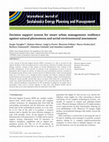
A new concept of Decision Support System (DSS) is presented. It is able to account for and suppor... more A new concept of Decision Support System (DSS) is presented. It is able to account for and support all phases of the risk analysis process: event forecast, prediction of reliable and accurate damage scenarios, estimate of their impact on Critical Infrastructures (CI), estimate of the possible consequences. It also provides an estimate of the consequences in terms of service degradation and of impact on citizens, on urban area and on production activities, essential for the mitigation of the adverse events. It can be used in two different modes, either in an operational mode (on a 24/7 basis) or in a simulation mode to produce risk analysis, setting up synthetic natural hazards and assessing the resulting chain of events (damages, impacts and consequences). Among the various possible external data sources an aerial, drone based one is presented. The system may capture both thermal and visual images of CI, processing them into 3D models or collect chemical pollutants concentrations fo...
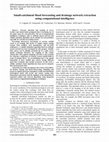
The 2006 IEEE International Joint Conference on Neural Network Proceedings
Forecast, detection and warning of severe weather and related hydro-geological risks is becoming ... more Forecast, detection and warning of severe weather and related hydro-geological risks is becoming one of the major issues for civil protection. The use of computational intelligence techniques such as artificial neural network and cellular automata algorithm can be suitable for such problems especially for real time forecasting system. Nowcasting (short-term forecasting) of extreme rainfall events is an example that invites to exploit remote sensing systems from satellites, such geostationary and low-orbit radiometers. A rainfall estimation algorithm based on artificial neural network has been developed for this purpose. Satellite data sources can be globally provided but at a quite coarse spatial resolution, therefore, the coupling of rain remote sensing data with regional raingauge networks is also essential for ensuring a calibration of remotely sensed rainfall fields in terms of ground effects. An overwhelming issue is the spatial integration of these rainfall data sources having different space-time resolution and variable accuracies. In this work a cellular automata based algorithm has been used to integrate these heterogeneous data. A flood forecast chain, developed at the Centre of Excellence for Remote Sensing and Hydro-Meteorology Modelling and based on coupled mesoscale atmospheric model and distributed hydrological model with in-situ and remote sensing data integration is presented, with the emphasis on the integration of numerical models and retrieval algorithms using integrated tools based on computational intelligence techniques. I. INTRODUCTION Hydrological modelling is becoming more and more needed for correct simulation of the hydrometeorological cycle and the surface energy flux exchange, both when they are coupled with a meteorological model, and alone when floods and drainage investigations have to be performed. Spatially distributed hydrological models are able to account for the spatial variability of physical properties and for this aim they need an accurate representation of the internal drainage structure of the watershed. There is a need Manuscript received March 27, 2006.
Hydrology and Earth System Sciences, 2020

Atmosphere, 2019
The response of Mediterranean small catchments hydrology to climate change is still relatively un... more The response of Mediterranean small catchments hydrology to climate change is still relatively unexplored. Regional Climate Models (RCMs) are an established tool for evaluating the expected climate change impact on hydrology. Due to the relatively low resolution and systematic errors, RCM outputs are routinely and statistically post-processed before being used in impact studies. Nevertheless, these techniques can impact the original simulated trends and then impact model results. In this work, we characterize future changes of a small Apennines (Central Italy) catchment hydrology, according to two radiative forcing scenarios (Representative Concentration Pathways, RCPs, 4.5 and 8.5). We also investigate the impact of a widely used bias correction technique, the empirical Quantile Mapping (QM) on the original Climate Change Signal (CCS), and the subsequent alteration of the original Hydrological Change Signal (HCS). Original and bias-corrected simulations of five RCMs from Euro-CORDE...
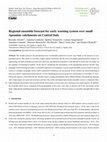
Hydrology and Earth System Sciences Discussions, 2019
The weather forecasts for precipitation have considerably improved in recent years thanks to the ... more The weather forecasts for precipitation have considerably improved in recent years thanks to the increase of computational power. This allows to use both a higher spatial resolutions and the newly developed parameterization schemes for representing sub-grid scale physical processes. However, precipitation estimation is still affected by errors that can impact on the response of hydrological models. To the aim of considering the uncertainties in the precipitation forecast and how they propagate in the hydrological model, an ensemble approach is investigated. A meteo-hydro ensemble system is built to forecast events in a complex orography terrain where catchments of different size are present. In this context, the meteo-hydrological forecast system is implemented and tested for a severe hydrological event occurred over Central Italy on November 15, 2017. During this period, a flash flood hit the Abruzzo region causing precipitation up to 200mm/24hours and producing damages with a high impact on social and economic activities.The newly developed meteo-hydro ensemble system is compared with a high resolution deterministic forecast and with the observations over the same area, showing a very good response. In addition, the ensemble allows for an estimation of the predictability of the event a few days in advance and of the uncertainty of this flood. Although the modelling framework is implemented on the basins of Abruzzo region, it is portable and applicable to other areas. 1 Introduction Floods and extreme rainfall are one of the major natural hazards in Europe with over 1000 fatalities and an estimate cost of about 5.000 billion of Euros in damages, between 1998-2009 only (European Environment Agency , 2010). Italy is one of the countries more exposed to hydrogeological risk in the Mediterranean basin, with more than 90% of municipalities affected by flood and landslide risk (ISPRA , 2018). From 2013 to 2017, 67 casualties due to floods have been reported, with 26 casualties in 2018 only (IRPI-CNR , 2019). The Mediterranean basin is characterized by a highly urbanized coast and mountain ridges close to the coast. During the autumn season, when large gradients are occurring because of the cooler atmosphere and the warmer sea favoring heat and moisture fluxes, there is an increase of the energy available for storms (Duffourg and Ducrocq , 2011). That is why most of the heavy rainfall and floods are occurring in autumn in the Mediterranean area (

Atmospheric Pollution Research, 2017
Abstract Atmospheric particulate matter (PM) is one of the pollutant that may have a significant ... more Abstract Atmospheric particulate matter (PM) is one of the pollutant that may have a significant impact on human health. Data collected during three years in an urban area of the Adriatic coast are analysed using three models: a multiple linear regression model, a neural network model with and without recursive architecture. Measured meteorological parameters and PM10 concentration are used as input to forecast the daily averaged concentration of PM10 from one to three days ahead. All simulations show that the neural network with recursive architecture has better performances compared to both the multiple linear regression model and the neural network model without the recursive architecture. Results of PM forecasts are compared with the air quality limits for health protection to test the performance as operational tool. The inclusion of carbon monoxide (CO) concentration as further input parameter in the model, has been evaluated in terms of forecast improvements. Finally, all models are used to forecast the PM2.5 concentration, using as input the meteorological data, the PM10 and CO concentration, to simulate the situation when PM2.5 is not observed. The comparison between observed and forecasted PM2.5 shows that the neural network is able to forecast the PM2.5 concentrations even if PM2.5 is not included among the input parameters.

L’Aquila, a distributed grid-based hydrological model (CHYM) has been developed to provide a gene... more L’Aquila, a distributed grid-based hydrological model (CHYM) has been developed to provide a general purpose model for operational flood warning activity. This paper presents two new cellular automata (CA) algorithms used respectively for drainage network extraction and rainfall data assimilation. The first is a cellular automaton-based algorithm for the extraction of a drainage network from an arbitrary digital elevation model. It has been implemented and tested on a large number of different domains. This algorithm is able to define the flow direction at every point on the digital elevation model where singular points are present (pits or flat areas). The second is a CA-based numerical technique for assimilating different data sources of rainfall to rebuild the rainfall field on a grid. This technique has been shown to produce a reasonable rainfield shape without any geometrical artefacts that often produce unrealistic rain gradients in the rainfield. Key words hydrological model; cellular automata; CHYM; drainage network extraction Algorithmes d’automates cellulaires pour l’extraction du réseau de drainage et l’assimilation de données pluviométriques Résumé Depuis 2002, dans le cadre du centre d’excellence Cetemps à l’université de L’Aquila, un modèle hydrologique distribué maillé (CHYM) a été développé pour fournir une modélisation générale
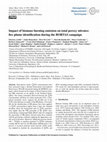
Atmospheric Measurement Techniques Discussions, 2016
The total peroxy nitrates (∑PNs) concentrations have been measured using a thermal dissociation l... more The total peroxy nitrates (∑PNs) concentrations have been measured using a thermal dissociation laser induced fluorescence (TD-LIF) instrument during the BORTAS campaign, which focused on the impact of boreal biomass burning emissions on air quality in the Northern hemisphere. The strong correlation observed between the ∑PNs concentrations and those of the carbon monoxide (CO), a well-known pyrogenic tracer, suggests the possible use of the ∑PNs concentrations as marker of the biomass burning (BB) plumes. We applied both statistical and percentile methods to the ∑PNs concentrations, comparing the percentage of BB plume selected using these methods with the percentage evaluated applying the approaches usually used in literature. Moreover, adding the pressure threshold (~ 750 hPa) to ∑PNs, HCN and CO, as ancillary parameter, the BB plume identification is improved. An artificial recurrent neural network (ANN) model was adapted to simulate the concentrations of ∑PNs and the HCN includi...

The Cetemps Hydrological model has been offline coupled with WRF-ARW and MM5 models in order to e... more The Cetemps Hydrological model has been offline coupled with WRF-ARW and MM5 models in order to estimate the possibility of flood occurrence. CHyM is a distributed grid based hydrological model implementing an explicit parameterization of different physical processes contributing to hydrological cycle, the model can be forced with temperature and precipitation scenarios predicted by MM5 or WRF model. In addition this model implements the calculus of two different alarm indexes providing a map of the segments of hydrological network where floods are more likely to occur. The WRF simulations are characterized by two domains running independently. The larger domain covers Europe with a horizontal resolution of 12 km using as analysis the ECMWF model, instead, the inner one covers Italy with a grid spacing of 3 km using as boundary and initial conditions the output from the low resolution simulation. CHyM alarm maps are described and the results for cases study occurred during HyMeX cam...

Science of The Total Environment, 2015
Hourly concentrations of ozone (O3) and nitrogen dioxide (NO2) have been measured for 16years, fr... more Hourly concentrations of ozone (O3) and nitrogen dioxide (NO2) have been measured for 16years, from 1998 to 2013, in a seaside town in central Italy. The seasonal trends of O3 and NO2 recorded in this period have been studied. Furthermore, we used the data collected during one year (2005), to define the characteristics of a multiple linear regression model and a neural network model. Both models are used to model the hourly O3 concentration, using, two scenarios: 1) in the first as inputs, only meteorological parameters and 2) in the second adding photochemical parameters at those of the first scenario. In order to evaluate the performance of the model four statistical criteria are used: correlation coefficient, fractional bias, normalized mean squared error and a factor of two. All the criteria show that the neural network gives better results, compared to the regression model, in all the model scenarios. Predictions of O3 have been carried out by many authors using a feed forward neural architecture. In this paper we show that a recurrent architecture significantly improves the performances of neural predictors. Using only the meteorological parameters as input, the recurrent architecture shows performance better than the multiple linear regression model that uses meteorological and photochemical data as input, making the neural network model with recurrent architecture a more useful tool in areas where only weather measurements are available. Finally, we used the neural network model to forecast the O3 hourly concentrations 1, 3, 6, 12, 24 and 48h ahead. The performances of the model in predicting O3 levels are discussed. Emphasis is given to the possibility of using the neural network model in operational ways in areas where only meteorological data are available, in order to predict O3 also in sites where it has not been measured yet.
Water Science and Technology Library
Abstract Within the activities of Cetemps Center of Excellence of University of L'Aq... more Abstract Within the activities of Cetemps Center of Excellence of University of L'Aquila, a distributed grid based hydrological model has been developed with the aim to provide a general purpose tool for flood alert mapping. One of the main characteristic of this model ...
Advances in Global Change Research, 2001
The Lake Fucino was the largest reservoir of fresh water in the Abruzzo Region until it was drain... more The Lake Fucino was the largest reservoir of fresh water in the Abruzzo Region until it was drained at the end of last century. The surface of the lake was about 150 square km. Temperature and precipitation historical records show appreciable changes in these ...
Science of The Total Environment, 2014






Uploads
Papers by Barbara Tomassetti